
Dillwynia tenuifolia is a species of flowering plant in the family Fabaceae and is endemic to eastern New South Wales. It is an erect shrub with linear leaves, and orange-yellow and red flowers.

Dillwynia cinerascens, commonly known as grey parrot-pea, is a species of flowering plant in the family Fabaceae and is endemic to south-eastern Australia. It is an erect to low-lying shrub with linear or thread-like leaves and orange or yellow flowers.
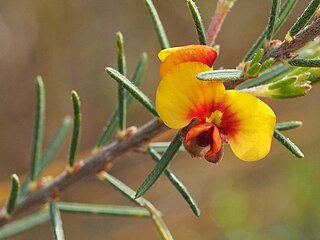
Dillwynia sericea, commonly known as showy parrot-pea, is a species of flowering plant in the family Fabaceae and is endemic to south-eastern Australia. It is an erect to low-lying shrub with hairy stems, linear leaves and apricot-coloured flowers, usually with a red centre.

Dillwynia floribunda is a species of flowering plant in the family Fabaceae and is endemic to eastern Australia. It is an erect shrub with hairy stems, crowded, grooved, linear leaves and yellow flowers with red markings.
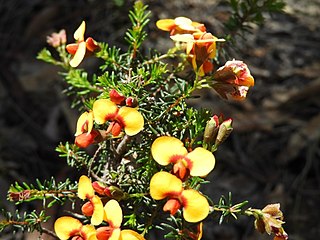
Dillwynia phylicoides, commonly known as small-leaf parrot-pea, is a species of flowering plant in the family Fabaceae and is endemic to eastern Australia. It is an erect to open shrub with twisted, linear to narrow oblong leaves, and yellow and red flowers.
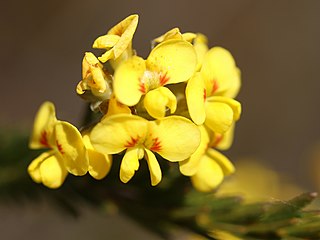
Dillwynia elegans is a species of flowering plant in the family Fabaceae and is endemic to eastern New South Wales. It is an erect shrub with more or less cylindrical, grooved leaves and yellow flowers with red markings.

Dillwynia acicularis is a species of flowering plant in the family Fabaceae and is endemic to New South Wales. It is an erect shrub with linear, grooved leaves and yellow flowers with red markings.
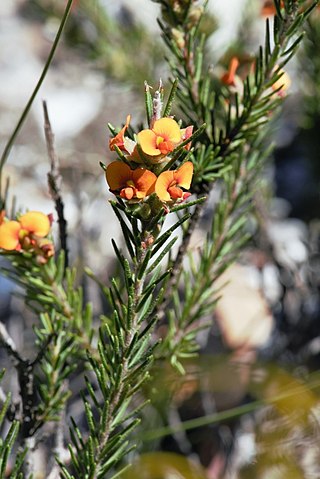
Dillwynia brunioides, commonly known as sandstone parrot-pea, is a species of flowering plant in the family Fabaceae and is endemic to New South Wales. It is an erect shrub with silky-hairy stems, linear, grooved leaves and yellow flowers with red markings.

Dillwynia crispii is a species of flowering plant in the family Fabaceae and is endemic to Morton National Park in eastern New South Wales. It is an erect shrub with glabrous, linear leaves and yellow flowers with red markings.

Dillwynia glaucula, commonly known as Michelago parrot-pea, is a species of flowering plant in the family Fabaceae and is endemic to south-eastern New South Wales. It is an erect shrub with lenticels on the stems, linear, grooved leaves and yellow flowers with red markings.

Dillwynia hispida , commonly known as red parrot-pea, is a species of flowering plant in the family Fabaceae and is endemic to south-eastern Australia. It is an erect shrub with more or less glabrous stems, linear to thread-like leaves and orange and red, partly crimson flowers.
Dillwynia juniperina, commonly known as prickly parrotpea, is a species of flowering plant in the family Fabaceae and is endemic to south-eastern continental Australia. It is an erect, spreading shrub with rigid, linear, sharply-pointed leaves and yellow flowers with red markings.
Dillwynia palustris is a species of flowering plant in the family Fabaceae and is endemic to the Snowy Mountains in New South Wales. It is a weakly ascending to low-lying shrub with glabrous stems, linear, spirally twisted leaves and orange or yellow flowers with red markings.
Dillwynia parvifolia is a species of flowering plant in the family Fabaceae and is endemic to New South Wales. It is a spreading to erect shrub with twisted, narrow oblong leaves and yellow flowers with red markings.

Dillwynia prostrata, commonly known as matted parrot-pea, is a species of flowering plant in the family Fabaceae and is endemic to south-eastern continental Australia. It is a prostrate shrub with hairy stems, linear to narrow oblong or spatula-shaped leaves and yellow and dark red flowers.
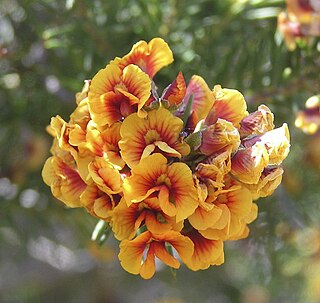
Dillwynia pungens is a species of flowering plant in the family Fabaceae and is endemic to the south coast of Western Australia. It is an erect, spindly shrub with cylindrical leaves and yellow flowers with red or orange markings.

Dillwynia ramosissima, commonly known as bushy parrot-pea, is a species of flowering plant in the family Fabaceae and is endemic to south-eastern continental Australia. It is a low-lying to erect shrub with linear to narrow oblong or spatula-shaped leaves and yellow flowers with red markings.

Dillwynia rudis is a species of flowering plant in the family Fabaceae and is endemic to eastern New South Wales. It is an erect shrub with warty, linear leaves and yellow to orange flowers with red veins.

Dillwynia sieberi, commonly known as Sieber's parrot-pea, is a species of flowering plant in the family Fabaceae and is endemic to eastern Australia. It is an erect shrub with rigid, needle-shaped, sharply-pointed leaves and yellow to yellow-orange flowers with reddish-brown markings.

Dillwynia uncinata, commonly known as silky parrot-pea, is a species of flowering plant in the family Fabaceae and is endemic to southern Australia. It is an erect, spreading shrub with cylindrical leaves and yellow flowers with a red centre.

















